Bernalillo County's cop squad is one animal-lovers are happy to see
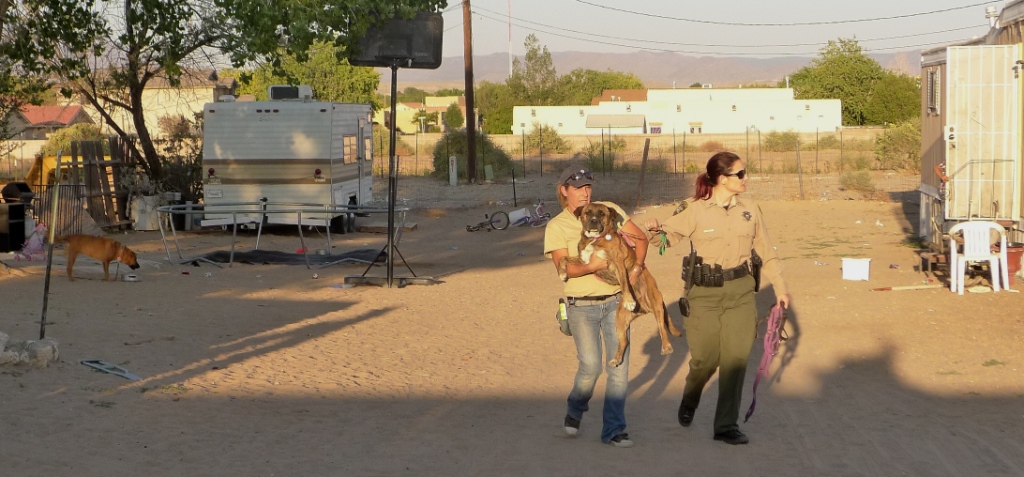
Bernalillo County Sheriff's Lt. Andrea Taylor (right) and Angela Stell of NM Dog work a trailer park on the Pajarito Mesa, educating animal owners about proper care and, in this case, returning a chained dog to the right owner.
Since 2012, the Bernalillo County Sheriff’s Office, together with Bernalillo County Animal Care and the rescue group NM Dog, periodically has conducted door-to-door sweeps of neighborhoods where animal violations are common. Thanks to passage this year of a county ban on tethering dogs, it’s gotten a lot easier to find homes where animal owners can be questioned and educated about humane animal treatment—or cited.
“We don’t want to take away people’s animals,” notes Lt. Andrea Taylor, the animal-loving force behind the animal-lovers’ force. “I tell my deputies, if someone doesn’t know, educate them. If they don’t care, that’s when we need to get involved.”
Lt. Taylor, or Andi, as she is known, hardly seems like your typical cop. Lively and friendly, with Elizabeth Taylor eyes, she’s cheerful, casual, high-energy—a South Valley homegirl, or at least enough of one to navigate the South Area Command, or South Squad. The fact that she has an eye to making captain at an age when many women are having babies speaks to some steely hidden reserves.
That steel becomes apparent when it comes to protecting the county’s four-legged creatures. A selfprofessed animal nut, Taylor initiated the PET, or Proactive Enforcement Team, with Matt Pepper, director of Bernalillo Animal Care, in 2012. Working on a case together of an abandoned calf, they realized the extent of what is known as “the deadly link” between animal cruelty and other kinds of crime.
“We rode together on Bridge Boulevard one day, and were shocked at what we saw,” Taylor recalls. Together they proposed an education program for deputies and the crime sweeps, which won approval from the Sheriff’s Office and Public Safety Division under a plan that doesn’t cost the taxpayers extra money.
Several times a year, when her deputies have an assigned training day, Taylor brings a half dozen of them out with what is now known as the Bernalillo County Animal Cruelty Task Force. Cops, animal control, and NM Dog (formerly New Mexico Dogs Deserve Better) walk a neighborhood door to door, acting on tips and what they see. A dog that’s chained, a mama with puppies, or an emaciated horse leads to a knock on the door and, if no one answers, a notice from animal control that says they will follow up.
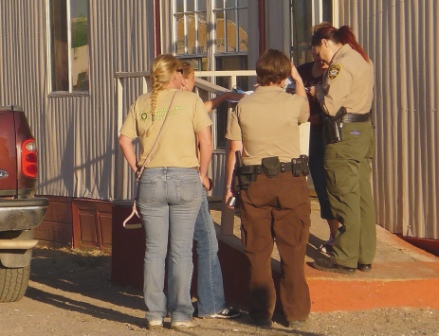
ON THE MOST RECENT SWEEP, on a warm day in early September, a dozen of us fanned out on the Pajarito Mesa, a little-known, impoverished immigrant neighborhood (colonia) that is largely off the grid. Faded houses wilt in the hot sun, surrounded by broken cars, children’s toys, and construction materials. Chained dogs are the norm here, as is the occasional horse fenced in a tiny dirt lot.
Early in the shift, the deputies hit pay dirt when they came across an emaciated horse and six dogs, all of which were surrendered by the owner. Acting on a tip, the group had found the dogs in sick condition, and the house in such bad shape that child welfare (CYFD) was called. The children were taken into temporary custody, as the bug-infested home with no window panes was deemed uninhabitable. The mother was arrested, but claimed no other adults were involved.
“The Pit Bull will probably have to be put down, he was so sick,” Taylor relates. “The five Chihuahuas are going to rescue.” In the backyard were an additional 100 roosters with their combs and wattles removed, some of them tethered—all signs of cockfighting. “She said they were for the kids to play with,” Taylor says, rolling her eyes. “So we will be watching that house.”
Cockfighting and dog fighting are heavily rumored in the South Valley, but hard to catch. Just once Taylor was able to break up a dog fight and make arrests, in 2009—a news report she has taped to her office wall. We cruise past a house where dog fighting is rumored, and you can see the resolve in her determined look, which disappears behind an air of cheerful goodwill when we confront the next wary homeowner.
At a large yard with a stable, a man has returned from work to find his yard full of cops and his wife waiting nervously. He has a nursing Bulldog with two adorable puppies (being sold for $500 each, he says), but no breeding license. The stable is large, and the horses in good shape, apparently because they are raced at the Downs.
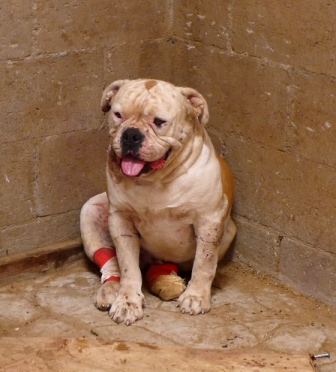
In a corner of a dirty stall we find the Bulldog daddy, a victim of an attack by coyotes. Bandaged and panting, he has flies buzzing his head and a food dish alive with bugs. The owner says the dog has been seen by a vet, that he is being treated with antibiotic, that the stalls are being sprayed for flies— anything, it seems, to end our visit. Taylor suggests the dog might be better off inside, but this is clearly not going to happen.
Racing horses is apparently as common as breeding dogs in this neighborhood, because we soon come across another stable thrown together from mismatched pieces of plywood. Clean stalls for a dozen horses in good condition are overseen by a stable hand who explains that their mouths are tied shut because they are racing tomorrow, and should not eat. It’s pitiful but not illegal, so we head out.
The house had drawn notice because of a dog tied to the hitch of a truck. Officers find another dog tethered in a cage full of feces. The dogs drink thirstily when the deputies provide water. Handfuls of kibble thrown on the ground is apparently how they are fed.
At every house with a chained dog, Angela Stell and her crew from NM Dog are ready with big sacks of premium organic dog food and feeding instructions, proper collars to replace ropes and chains, and a promise to help put up fences; by the end of the day they will have a list of a half dozen jobs. Dogs that are surrendered, she takes to join the dozen or more the group keeps at boarding kennels and foster homes across Albuquerque, where they will be socialized, trained, and adopted. The revolving door of dogs seems exhaustingly infinite, but Stell shares with Taylor an amazing energy to help every single dog she can. It is as wondrous that they joined forces as inevitable that they would.
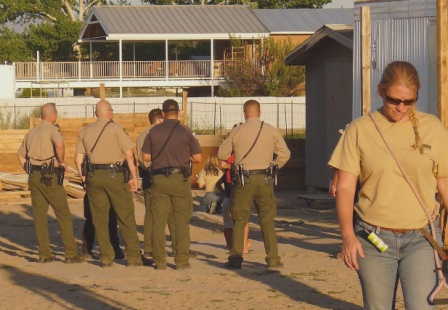
"WE ALWAYS FOLLOW UP," Taylor says as we walk the lane of a trailer park where animal control officers had left notices a week before. None of the homes given warnings have unchained their dogs, and now they are getting citations. It is dismaying how quickly the owners deliver the same response: pointing the finger at another dog owner down the street (always of “vicious Pit Bulls”), sending out the wife or kids to do the talking, suddenly losing all ability to understand English.
Taylor says people complain that police don’t set foot in the neighborhood, but the fact is they are rarely called— clearly because there are so many illegal immigrants and drug lords. Seeing a phalanx of “guns” in khaki shirts walking down the street seems to put the neighborhood on edge, but Matt Pepper believes it also sends the message that the police can be a source of help.
“On (the last sweep), people began to interact with us, to want to show us their dogs, and see us as a resource,” he says. “Most people want to do the right thing.”
Tips from the community are, in fact, the best way to uncover animal cruelty, which is otherwise easy to hide. And it is at a house known to NM Dog for past violations that the task force ends its day in victory, hours after dark. A chained dog turns out to have a broken leg and recent bite wounds, clearly in pain. When they walk the property, deputies find fresh blood on the ground and a “bite stick” of the kind used in dog fighting, as well as a circular area that looks like a pit.
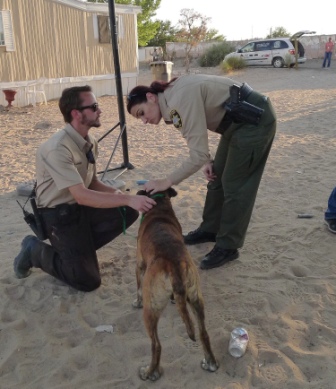
“The owners denied, denied, denied,” Taylor related later, adding that she tricked the man into saying he had not fought the dogs in two months. “I told him, I’m not dumb—I know what you’re doing here. You need to get these animals neutered because you have no breeders permit. I also said there’s evidence of dog fighting, and I’m very happy to come back with a search warrant and investigate.”
At that point, he immediately surrendered four dogs and two puppies. It wasn’t as good as an arrest, Taylor said, but “I’m going to watch him.” She reported the house to the zoning department for possible code violations, and “I plan to keep investigating further. And that’s six dogs off the street that would have lived a horrendous life—I feel pretty good about that.”
AS THE DAY'S WALK has shown, animal abuse can unearth a chain reaction of problems—like children living in conditions as bad as the dogs. The participating deputies have gotten practice spotting signs of animal abuse. And the neighborhood has been put on alert that people are watching.
“We are the first force in the state doing this,” Taylor says of the participation with animal control, which they just presented at the ASPCA’s 2013 New Mexico Conference on the Link Between Animal Cruelty and Human Violence. The hope is that the example will spread to rural counties that, though they may never rate an episode of CSI, suggest the norm of chained and abused animals is just the tip of a mountain of hidden human tragedy.
